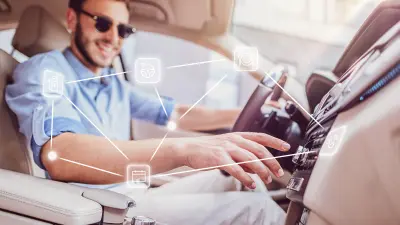Smart Charging – intelligent electric vehicle charging
Algorithms ensure optimized charging within an existing charging infrastructure
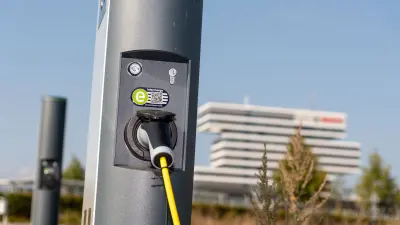
New challenges for the charging infrastructure for electric vehicles
The share of electric vehicles is increasing and will continue to do so in the future. That is good for the environment and in terms of sustainability – but presents new challenges for operators of a charging infrastructure for electric vehicles. Take the example of a company car park: What if, in the future, employees all came to work with electric cars, connected them to the charging station in the morning – and all cars started charging at the same time? How can such peak loads be avoided? And how can it be ensured that the energy management system uses electricity from renewable sources such as photovoltaic systems efficiently – thereby not only making a further contribution to sustainability, but also massively reducing electricity costs? Alexander Koch, Moritz Bräuchle and their team at Bosch Research deal with precisely these questions. They are developing the cloud-based energy management system Smart Charging, which enables optimized and intelligent charging of electric vehicles.

Alexander Koch
- Alexander Koch is a research engineer and industrial engineer for power plant technology and has been with Bosch Research for five years. In the Smart Charging project, he is particularly concerned with fleet charging.
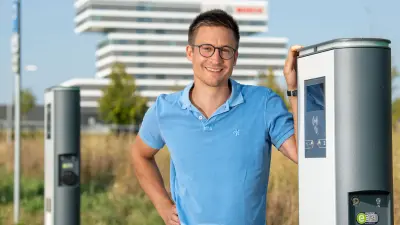
Moritz Bräuchle
- Moritz Bräuchle has been active in various Bosch divisions for a total of nine years, including the development of solar inverters. In the research field of Smart Charging, the research engineer concentrates in particular on the single electric vehicle.
Optimized charging thanks to Smart Charging
Alexander, Moritz, what distinguishes your Smart Charging approach from other approaches to charging electric vehicles?
Alexander: The Smart Charging project emerged from a cross-functional project here at Bosch. At that time, we were mainly concerned with the question: What can smart charging at home look like? This means: How can the charging process in the car be controlled, how do we communicate with the user’s energy management service? From this, our current project developed at the beginning of 2020, in which the focus is no longer on the individual household and the direct communication with the vehicle. Instead, we are working on a cloud-based energy management system at Smart Charging Enterprise, which uses the existing charging infrastructure for electric vehicles and communicates directly with the charging point via the charging point operator back end. We want to achieve optimized charging of electric vehicles according to certain parameters – for individual cases, but especially in the enterprise application case with a large number of vehicles, the so-called fleet charging.
Moritz: We are working on a framework to establish a charging management system and are developing algorithms that can be used to create an optimal charging plan for a location. In this context, optimal means that it considers not only the requirements of the individual vehicles, but also factors such as the current and future price of electricity, the availability of renewable energy such as from photovoltaic systems, and the general load of the location. This way, peak loads and high electricity prices can be avoided – while also contributing to a location’s sustainability.
Smart Charging Residential:
In contrast to Smart Charging Enterprise, the Smart Charging Residential project, which was funded as an innovation project within the Bosch Group, focused on the question of what intelligent charging at home could look like. The resulting Smart Charging Residential service is now being marketed as a cloud-based service from Bosch Connected Mobility Solutions, bundled with other services for a convenient charging experience as a software solution for OEMs. The driver can conveniently charge his electric vehicle with his own solar electricity. It is also possible to adapt the charging behavior to dynamic electricity prices and to charge the vehicle when the electricity price is low. As a result, the user can halve his electricity bill and uses three times the amount of electricity he generates himself compared to conventional charging.
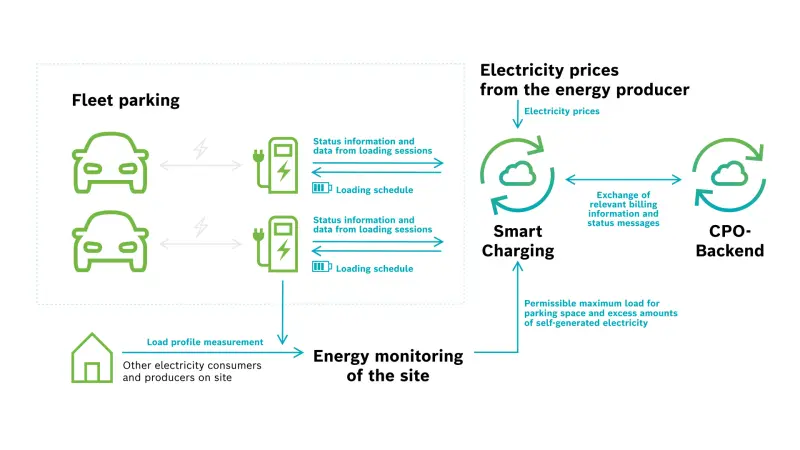
What makes Smart Charging so sustainable?
Moritz: In contrast to vehicles with combustion engines, electric vehicles have great potential to contribute to the reduction of harmful CO2 emissions in the future. However, they can only fully develop this potential if they are charged with clean energy. It is of little use if the electric vehicles themselves produce no emissions, but are charged with electricity from a coal-fired power station. This is why the algorithm we are developing for Smart Charging explicitly considers the effective use of renewable energies in addition to the electricity price and the site loads. An example: Current charging systems regulate the timing – the sun is shining, we have a certain amount of energy and we can distribute it over all vehicles in a company car park. But our goal is to make forecasts, or in other words to look into the future. For example, a driver has to leave soon, and his vehicle has to be fully charged beforehand. However, a cloud front is currently moving in and the energy from the photovoltaic system will decrease accordingly. We incorporate such data and forecasts up to seven days in advance into our model and can thus achieve, in the best case, optimized charging at the lowest prices and with the highest possible proportion of renewable energy. Of course, this is crucial for the fleet planning of companies.

Vehicles with combustion engines still dominate in company fleets as well as in employee parking lots. E-cars can only be found sporadically. Do we even need such a sophisticated energy management system for fleet charging?
Alexander: Of course – if not today, then the day after tomorrow at the latest. Our research is directed toward the future, in which significantly more electric vehicles will be on the road. And already today we see: The increasing share of electric vehicles is very good in terms of sustainability, but poses great challenges for both operators of a charging infrastructure for electric vehicles and for companies.
More and more people drive to work with an e-car and want to charge it there during the day. An increasing number of people are also using electric vehicles for shopping and want to charge their batteries there too. In addition, more and more bus or logistics fleets operate electrically. We therefore need parking spaces with an appropriate charging infrastructure for electric vehicles. And it must not simply provide all the energy to all vehicles immediately – otherwise there would be peak loads which, in addition to high electricity costs and possibly a low proportion of renewable energies, could also lead to the respective location being overloaded – and could cause a fuse to blow, for example.

And how can such serious “misallocations” be avoided by a charging infrastructure?
Alexander: We are currently developing an energy management system that prevents this problem by providing the greatest possible flexibility in energy use – for example by forecasting user behavior. For example, our algorithm is supposed to learn the respective loading requirements of the vehicles using their respective user IDs. The algorithm does not know who these users are and where they are going – but it should know what they need. The situation is similar in large bus depots or in the fleet planning of logistics companies: These are very dynamic systems in which the vehicles sometimes arrive and depart at minute or even second intervals. The energy management system must react flexibly in order to provide an optimal charging plan as quickly as possible. We are working on precisely such a solution that can cope with large, dynamic systems and can be used in many different ways with only minor adjustments, be it in bus depots, logistics companies or even company car parks. Here at our Bosch site in Renningen, for example, we could test an energy management system in which the smart charging of electric vehicles adapts to the site’s load profile to avoid peak loads.
Smart charging with peak reduction and spot market optimization
Fleet size
1000 EVs with connection times from 07:00 - 16:00 o'clock
Varying charge power
(~3-50 kW); daily demand per EV 6 kWh
Coworker EVs parked
on the parking lot may produce peak loads for companies
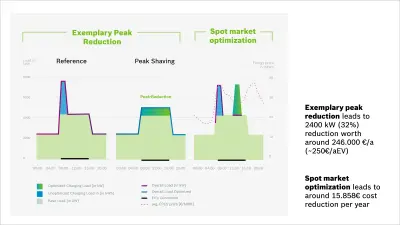
Besides fleet charging, the optimized charging of individual electric vehicles is the second focus of the Smart Charging project. What improvements are you talking about here?
Moritz: The charging of individual electric vehicles can of course also be organized more efficient and cheaper, with the highest possible proportion of renewable energy. So our research is, for example, about looking at which functions we can perform in advance, during the charging process, in order to save energy afterwards during operation. One example of this is the air conditioning of vehicles, such as heating the interior cabin. This is no problem at all for classic vehicles with combustion engines: The waste heat from the engine, which is available anyway, is used for heating. E-vehicles, however, hardly generate hardly any heat loss. So if we can predict the driver’s user behavior with Smart Charging, we can draw the energy needed to preheat the cabin from the grid just before departure – and thus help reduce energy consumption during the journey. Intelligent charging with an energy management system such as Smart Charging therefore also uses the energy from the power grid for individual vehicles in the wise foresight of saving the battery energy for later.

